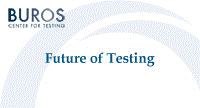Buros-Nebraska Series on Measurement and Testing

The Future of Testing
Date of this Version
1986
Document Type
Article
Citation
Published in The Future of Testing, edited by Barbara S. Plake & Joseph C. Witt (Hillsdale, NJ: Lawrence Erlbaum Associates, 1986).
Abstract
INTRODUCTION
Competency becomes an issue when one seemingly encounters incompetence and its consequences. For example, suppose an automobile is taken to a dealer for brake repair. Once the repair has presumably been completed, the owner drives the car to the first intersection, one block from the dealer, and the brake light in the dashboard appears. This owner would probably begin to question the competence of the attending mechanic. As consumers, employers, or even students, we witness countless other examples of probable incompetence.
It is this questioning of competence that provided the impetus for the minimum competency testing movement in this country. The movement which began in the 1970s developed in two distinct but interrelated fields: education and occupational licensing. In education, the public seriously questioned the meaning of the high school diploma and, in essence, the competence of a high school graduate. Coterminously, thousands of consumer complaints against licensed and certified practitioners brought into question the quality of services rendered and the conditions for relicensure. Although many of the issues in education and licensure are quite similar, especially in regard to assessment, only the competency movement in education will be reviewed here in order to avoid redundancy in this, chapter and with Kane's chapter in this volume.
Minimum Competence
Despite the recency of the minimum competency testing movement, the concept of minimum competence is not new. It has been an integral part of occupational licensing in the United States for more than 200 years. Licensing is “the process by which an agency of government grants permission to an individual to engage in a given occupation upon finding that the applicant has attained the minimal degree of competency necessary to ensure that the public health , safety , and welfare will be reasonably well protected" (U.S . Department of Health, Education, and Welfare, 1977, p. 4). This concern for “minimal competency" or “minimum qualifications" for safe practice underlies the state regulation of more than 800 occupations and professions (Greene & Gay, 1980; Shimberg, 198 1). Individuals seeking licensure, for example, physicians, pilots, electricians, lightning rod installers, or horseshoers (see Shimberg, 1982a, chap. 1), are usually required to pass an examination in order to demonstrate their competence. Shimberg (l982a) has listed three responsibilities of licensing boards using such an examination:
1. The examination is a satisfactory measure of competence; 2. It measures the critical and important knowledge, skills, and abilities prerequisite to performance of the job at the minimum level of competence deemed necessary for the public protection; and 3. It is capable of screening out those who lack the requisite level of competence. (p. 56)
The educational analogue of these characteristics will become apparent in subsequent sections of this chapter.
Another perspective on the concept considers minimum competence in the context of United States social policies. Cohen and Haney (1980) have pointed to the longstanding) interest in having government promotes minimum levels of social welfare. Examples include public health programs, social security, unemployment insurance, welfare programs, and, certainly, a free public education.
Throughout the relatively brief hi story of the competency testing movement the expression minimum competence has engendered a considerable amount of confusion among lay people and educators alike. In practice, it connotes both the type of competence to be measured and the performance standard that is specified to designate attainment of the competencies. A further discussion of this topic is given in the section on "Definitions."


Comments
Copyright © 1986 by Lawrence Erlbaum Associates. Digital edition copyright © 2012 Buros Center for Testing. This book may be downloaded, saved, and printed by an individual for their own use. No part of this book may be re-published, re-posted, or redistributed without written permission of the holder of copyright.